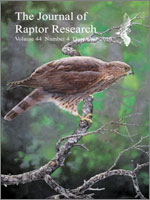Cooper's Hawks (Accipiter cooperii) have recently colonized many urban landscapes across North America, but data on breeding densities and trends in densities of these populations are lacking. We surveyed for woodland raptors throughout approximately 1000 km2 in the metropolitan Milwaukee, Wisconsin, area over a 21-yr period, 1988–2008. We documented the natural colonization of this urban landscape by a pioneer Cooper's Hawk population and its subsequent growth from 1993–2008 (4 to 41 laying pairs, 4 to 55 occupied sites). Nearest-nest distances decreased and the number of Cooper's Hawk laying pairs increased while nesting surveys remained consistent temporally and spatially, indicating that density of breeding pairs was increasing in the metropolitan Milwaukee area. Approximately 15 yr after initial colonization, the breeding density of Cooper's Hawks in some localized areas averaged one laying pair per 330 ha (range: 68–587 ha). From 1996–2008, as breeding density increased, average annual productivity (number of young/laying pair) for Cooper's Hawks in Milwaukee County, a subset of the overall larger metropolitan study area, also increased. During the early years of colonization, a relatively high proportion of individuals or pairs of birds appeared to occupy nest sites but did not breed. Younger birds may have played a role in the colonization of this urban landscape. This population was likely increasing at a relatively rapid rate during the late 1990s and continued to increase throughout the remainder of our study.
How to translate text using browser tools
1 December 2010
Colonization, Growth, and Density of a Pioneer Cooper's Hawk Population in a Large Metropolitan Environment
William E. Stout,
Robert N. Rosenfield

Journal of Raptor Research
Vol. 44 • No. 4
December 2010
Vol. 44 • No. 4
December 2010
Accipiter cooperii
colonization
Cooper's Hawk
pioneer population
population density
population trends
range expansion




